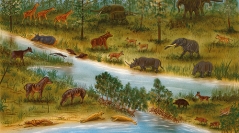

 Geodiversitas
38 (2) - Pages 147-151
Geodiversitas
38 (2) - Pages 147-151The fossiliferous site of Küçükçekmece was discovered by Ahmet Malik (1892-1965, Ahmet Malik Sayar after the 1934 Surname Act) on April 12th, 1932. During a field training with his students in the western suburbs of Istanbul, he observed bones coming out in a sand quarry near the village of Küçükçekmece, along the eastern bank of the lagoon of the same name. Professor Ahmet Malik was a geologist as understood at that time, i.e. not specialized in a branch of geology, but a naturalist of earth sciences. Ahmet Malik knew that the geology is learned both in the field as in the classroom, and for field practice, he took his students as often as possible for field training on outcrops in the vicinity of Istanbul. His discovery of the Küçükçekmece fossil site gave a new direction to his scientific objectives. After discovering this fossil site, Ahmet Malik decided to search for more fossils and to communicate on the wildlife. In collaboration with his colleague, the geologist Hamit Nafiz (H.N. Pamir after the 1934 Surname Act), they began the excavations at Küçükçekmece and unearthed hundreds of specimens of mammals, reptiles and fishes. With the permission and financial support of the university’s rector, Malik and Nafiz conveyed the Küçükçekmece fossils to the Natural History Museum of Paris. They studied there all vertebrate remains that this site yielded with the advice and help of Marcellin Boule and Camille Arambourg, eminent vertebrate paleontologists in this institution. They compared the Küçükçekmece fossils with those from well-known Miocene localities of Europe and Asia, which were available in the rich collections of this museum. They drafted soon the manuscript that was published in March 1933 as a monograph in the Publications of the Institute of Geology of the University of Istanbul. This monograph of 119 pages includes also one map and 16 plates with the photos of the site, of the excavation and of the best specimens of mammals. This is the first comprehensive work on Turkey vertebrate fauna and the first work in vertebrate paleontology by Turkish researchers.
Histoire, mammifères, site à fossiles, Küçükçekmece, Turquie